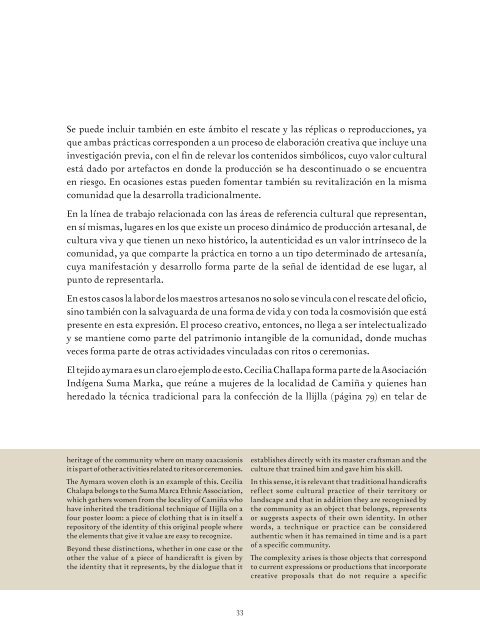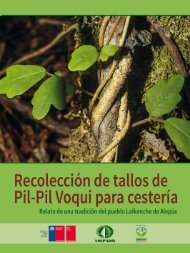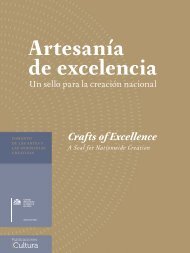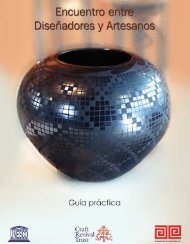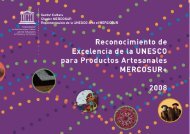artesania-excelencia
artesania-excelencia
artesania-excelencia
Create successful ePaper yourself
Turn your PDF publications into a flip-book with our unique Google optimized e-Paper software.
Se puede incluir también en este ámbito el rescate y las réplicas o reproducciones, ya<br />
que ambas prácticas corresponden a un proceso de elaboración creativa que incluye una<br />
investigación previa, con el fin de relevar los contenidos simbólicos, cuyo valor cultural<br />
está dado por artefactos en donde la producción se ha descontinuado o se encuentra<br />
en riesgo. En ocasiones estas pueden fomentar también su revitalización en la misma<br />
comunidad que la desarrolla tradicionalmente.<br />
En la línea de trabajo relacionada con las áreas de referencia cultural que representan,<br />
en sí mismas, lugares en los que existe un proceso dinámico de producción artesanal, de<br />
cultura viva y que tienen un nexo histórico, la autenticidad es un valor intrínseco de la<br />
comunidad, ya que comparte la práctica en torno a un tipo determinado de artesanía,<br />
cuya manifestación y desarrollo forma parte de la señal de identidad de ese lugar, al<br />
punto de representarla.<br />
En estos casos la labor de los maestros artesanos no solo se vincula con el rescate del oficio,<br />
sino también con la salvaguarda de una forma de vida y con toda la cosmovisión que está<br />
presente en esta expresión. El proceso creativo, entonces, no llega a ser intelectualizado<br />
y se mantiene como parte del patrimonio intangible de la comunidad, donde muchas<br />
veces forma parte de otras actividades vinculadas con ritos o ceremonias.<br />
El tejido aymara es un claro ejemplo de esto. Cecilia Challapa forma parte de la Asociación<br />
Indígena Suma Marka, que reúne a mujeres de la localidad de Camiña y quienes han<br />
heredado la técnica tradicional para la confección de la llijlla (página 79) en telar de<br />
heritage of the community where on many oaacasionis<br />
it is part of other activities related to rites or ceremonies.<br />
The Aymara woven cloth is an example of this. Cecilia<br />
Chalapa belongs to the Suma Marca Ethnic Association,<br />
which gathers women from the locality of Camiña who<br />
have inherited the traditional technique of IIijlla on a<br />
four poster loom: a piece of clothing that is in itself a<br />
repository of the identity of this original people where<br />
the elements that give it value are easy to recognize.<br />
Beyond these distinctions, whether in one case or the<br />
other the value of a piece of handicraftt is given by<br />
the identity that it represents, by the dialogue that it<br />
establishes directly with its master craftsman and the<br />
culture that trained him and gave him his skill.<br />
In this sense, it is relevant that traditional handicrafts<br />
reflect some cultural practice of their territory or<br />
landscape and that in addition they are recognised by<br />
the community as an object that belongs, represents<br />
or suggests aspects of their own identity. In other<br />
words, a technique or practice can be considered<br />
authentic when it has remained in time and is a part<br />
of a specific community.<br />
The complexity arises is those objects that correspond<br />
to current expressions or productions that incorporate<br />
creative proposals that do not require a specific<br />
33


